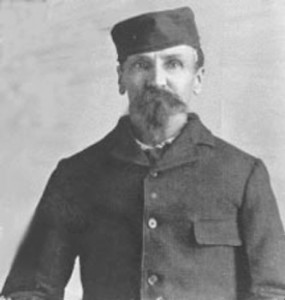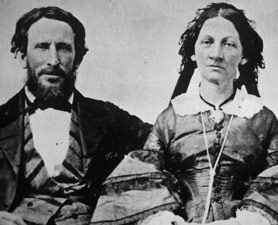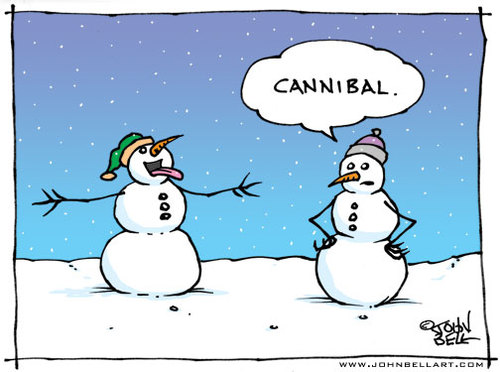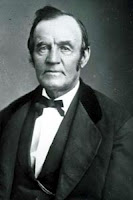There is no way to approach the topic of cannibalism without offending someone. Apologies offered. Cannibalism, the last great social taboo, is committed sometimes as a criminal act, sometimes to survive. Other times it is just bizarre as in a case reported 6 May 2012 in South Korea. There authorities cracked down on the smuggling of powdered baby flesh. Consumers bought the Chinese capsules for reasons ranging from fighting cancer to (yeph, you guessed it) improved sexual performance. The capsules sold for (in 2012 dollars) about $35 to $44 each.

In 1886 Alfred Packer was sentenced to 40 years for manslaughter that involved cannibalism. At the time it was the longest sentenced handed out in the United States. He was pardoned in 1901.
Criminals have long been associated with the practice of cannibalism, some by turn of mind others to conveniently eliminate evidence. Most criminal cannibals are loners and do not commit other crimes such as rape. Cannibalism was not unknown in sailing/shipwreck days. It was also practiced by various tribes for sundry reasons in tropical areas of the world, including the Caribbean and perhaps currently in remote Africa and south sea islands. There it is sometimes accompanied by a human wasting disease related to Mad Cow Disease, human spongiform encephalopathy (caused by nearly indestructible proteins that destroy brain cells.) Some equatorial tribes committed funerary cannibalism, that is, consuming their dead relatives to spare them the indignity of rotting. In fact, in some south sea cultures a young couple — a boy and a girl just past puberty — were feted in ceremony and then had sex in front of the entire tribe. A lean-to of heavy logs was dumped on them at the height of intercourse killing the couple. Their bodies were dragged out of the wreckage and then consumed, which is endocannibalism, within the group. As horrific as we may view this the natives did not. To them it was an affirmation of what many equatorial cultures viewed as the great circle, out of death comes life and that all eating is a eucharistic communion. To them it was a deeply religious act affirming their world and cosmological view. In North America Iroquoi tribes practiced ritualistic enemy-related cannibalism as late as 1838.
Cannibalism, or anthropophagy, is mentioned several times in the Bible, one of the more specific verses is II Kings 6:26-29. In the arts cannibalism was part of the genesis for the novel Moby Dick. The musical Sweeny Todd is based on the theme of cannibalism and, not unlike the capsules mentioned above, so was the 1973 movie Soylent Green. And one should mention the infamous Hannibal Lecter M.D. From a factual point of view group cannibalism has been decreasing for the last 100 years and individual cannibalism has been on the increase.
While socially condemned cannibalism is rarely specifically illegal. For example, Florida statutes do not mention “cannibals” or “cannibalism.” However, “a person who mutilates… or otherwise grossly abuses a dead human body commits a felony of the second degree…” A jury would probably agree cannibalism fits that law under some conditions. Setting aside for a moment legal, criminal and moral issues, does cannibalism save lives in difficult or emergency situations? The answer is yes and no. The issue is fat.
 Humans cannot survive long-term without ingesting fat. We can live without meat if we eat well and get a balance of amino acids. We can live completely without carbohydrates if we have enough fat and proteins (meat or amino acids) to eat. In fact we can live for a long time on just fat and water. But, we cannot live without fat, and fat is the make or break issue with cannibalism in regards to survival. Even ancient man preferred fat, bone marrow, and brains over muscle meat as evidenced by how he butchered animals and his occasional fellow man.
Humans cannot survive long-term without ingesting fat. We can live without meat if we eat well and get a balance of amino acids. We can live completely without carbohydrates if we have enough fat and proteins (meat or amino acids) to eat. In fact we can live for a long time on just fat and water. But, we cannot live without fat, and fat is the make or break issue with cannibalism in regards to survival. Even ancient man preferred fat, bone marrow, and brains over muscle meat as evidenced by how he butchered animals and his occasional fellow man.
If a group is starving together and are equally skinny eating one of the group is not going to help much or forestall death. Why? Because you have all been loosing fat together and have zero fat stores unless someone was more fat than the rest to begin with. Eating a person with little to no fat will provide proteins but not enough fat to survive. It is similar to documented cases of “Rabbit Starvation” which is dying from eating only rabbit meat which has little fat. Thus the Donner Party, which was stuck in the Sierra Nevada in the winter of 1846/47, resorted to cannibalism when it did little good, that is, after everyone had not eaten for a long time. (Though it should be mentioned some new research suggests they were not as cannibalistic as once thought.) The same situation as the Donner Party existed with the whaling ship Essex in the 1820s which was the inspiration for the novel Moby Dick. However, the Uruguayan Air Force Flight 571 that crashed Friday, 13 October 1972 was totally different.
Of the 45 on board the plane that crashed in the Andes 29 survived only to see eight killed in an avalanche later. They were at 11,800 feet. The dead froze within a matter of hours which is what saved those who later consumed them; their fat stores were available. The living were not rescued for 72 days and then only after two managed to climb down in spring weather and walk out for help. Crash survivors who did not participate in cannibalism died of starvation.

James F. Reed and his wife, Margret W. Keyes Reed, in the 1850s, were survivors of the 1846/47 Donner Party.
Let’s look at some nitty gritty statistics from these two events. First the Donner party. The survivors were on average 7.5 years younger than those who died; children between 6 and 14 had a much higher survival rate than infants and children under the age of 6 or adults over the age of 35. Then again, they were also cared for by the dying adults. No adults over the age of 49 survived. Deaths among males between 20 and 39 were “extremely high” at more than two out of three. Men metabolize protein faster, and women do not require as high a caloric intake. Women also store more body fat, which delays the effects of physical degradation caused by starvation and overwork. Men also tend to take on more dangerous tasks, and in the Donner case, the men before being snowed in were required to clear brush and engage in heavy labor, adding to their physical debilitation and less fat stores. Those traveling with family members had a higher survival rate than bachelors probably because family members more readily shared food with each other.
The Essex case was similar regarding the men. It was an all male working whaling ship. When the ship was intentionally struck and sunk by a sperm whale all hands made to smaller boats. The men began to die almost immediately and at first they were buried at sea. Then the decision was made to save their bodies. When they ran out of bodies they drew lots to decide whom to eat and who would kill that person to eat. The captain, George Pollard, actually ended up eating his cousin. Still men died, and the boats got separated. In the end three men left on a island managed to live as did a few who remained in boats.

Roberto Canessa and Nando Parrado, 1974, who survived the Andes crash and walked out to save their friends.
In the Andes case all the final survivors were male as well but they were also the majority of passengers. Further most of the males were young men in top physical condition at the time of the accident, unlike the Donner Party who had been laboring against the trail for weeks. The Andes crash survivors also knew they had to eat their teammates and other passengers to survive. Fortunately those bodies had frozen fast and had fat (and bone marrow.) A point to consider is all three groups of men had low fat stores, the athletes, the able-bodied sailors, and the men clearing a wagon train path. The most successful group, the athletes, were the only one with access to flash-frozen fat. They were also the youngest.
So, what do people taste like? The term “long pig” was coined just for that purpose. There has even been some speculation, by no less than the august commentator Christopher Hitchens, that the Semitic ban on eating pig is because the intelligent pig tasted like and sounded too much like humans, particularly in slaughter. In 1910, the American anthropologist, A. P. Rice, reported how natives of the Marquesas Islands ritualistically killed their human captives, called exocannibalism, or outside the group.
“First, they broke their legs, to stop them running away, then they broke their arms, to stop them resisting. This was an unhurried killing, because the Marquesans enjoyed observing their victim contemplating his fate. Eventually, the man would be skewered and roasted.” Eyes, brain and cheeks were regarded as delicacies by some cannibals.
While there are credible reports of native cannibalism as late as the 1970s, and perhaps even 2008, here’s an Australian account from 5 August 1865:
“… an observation of six males from the Kgut’dhirri (clan) … taken hold of a white male… was affronted by five of the Kgut’dhirri males… sudden movement of the sixth native who had come in from behind… attacker hit hard and cracked open his skull with the force of a large club… dead at the moment of striking despite the contortions of his body on the ground… With great haste, they took away his clothing leaving him naked on the ground…”
 “… three of them produced sharp European knives… relieved him of his innards… arms and legs were trussed with vine in the manner of a captured iguana… in two swift strokes, cut away the victim’s appendices… held them high in his hand… gave forth a cry of victory… placed his trophy in a dilly bag… carried forth the poor soul’s body on a pole towards their camp… old women… examined the body… placed large logs on the fire… given a coat of grease to the body… the body was in place on the coals of the fire… knew of no other time or place where a white man was killed and eaten… “
“… three of them produced sharp European knives… relieved him of his innards… arms and legs were trussed with vine in the manner of a captured iguana… in two swift strokes, cut away the victim’s appendices… held them high in his hand… gave forth a cry of victory… placed his trophy in a dilly bag… carried forth the poor soul’s body on a pole towards their camp… old women… examined the body… placed large logs on the fire… given a coat of grease to the body… the body was in place on the coals of the fire… knew of no other time or place where a white man was killed and eaten… “
And one from 11 June 1854: “… taken to cover overlooking a large camp of natives… was able to observe an orgy of utter revulsion… in a frenzied motion uttering sounds of madness… consumed a liquid resembling the content and color of blood… dark bodies were coated with much spillage… witness to a human feast… some ten corpses… ten more victims awaiting a similar fate… a victim brought forward… struck from behind… neck was cut… blood filled containers… head was severed and split… old men took possession of the brain, eyes and tongue… separate cooking stones… body was then gutted… heart was handed to the leader… placed also on the special cooking stones… strips of sweet meat were taken from the lower back… given to all the (old) men and placed on the stones… these parts are important… men gained the knowledge, the sight, speech skills, soul and the strength of the victim…”
“… the victors took portions of the liver and all of the male’s appendix parts… liver was eaten raw… the man’s prides were placed on the coals for roasting… body was trussed and hung on a frame above the coals. The odor drifting in the air was of burning flesh. When cooked, the arms and legs or preferred portions of those limbs were shared between the men… why such rituals are performed… told that the liver of a man resembled life because it was full of blood… quenches the thirst like water… eating of the male’s appendices passed on the prowess of the victim in his mating capacity… legs and arm pieces represented the strengths of the victim… all the males duly shared. The ritual of sharing the body was completed when the rest was left to the women and the children.”
 There are many such gruesome reports and pictures. Most recently in October of 2015 there was a news report from Argentina in which a 25-year old, one Leandro Acosta, was arrested on murder charges. He ate his step-father, Ricardo Klein, and said the 54-year old “tasted like pork, a tad salty but delicious.”
There are many such gruesome reports and pictures. Most recently in October of 2015 there was a news report from Argentina in which a 25-year old, one Leandro Acosta, was arrested on murder charges. He ate his step-father, Ricardo Klein, and said the 54-year old “tasted like pork, a tad salty but delicious.”
Modern scholars say “cannibalism” was misunderstood by European explorers who also used or consumed human flesh from blood to mummy remains to treat disease and… improve sexual performance… The scholars tell us the cultural clash was used as an excuse to colonize.
While that may indeed be true there are among the anthropophagy accounts, interestingly, the gastronomic view that people who use tobacco don’t taste good when roasted. Perhaps a skinny chain smoker has the greatest chance of not being dinner….





